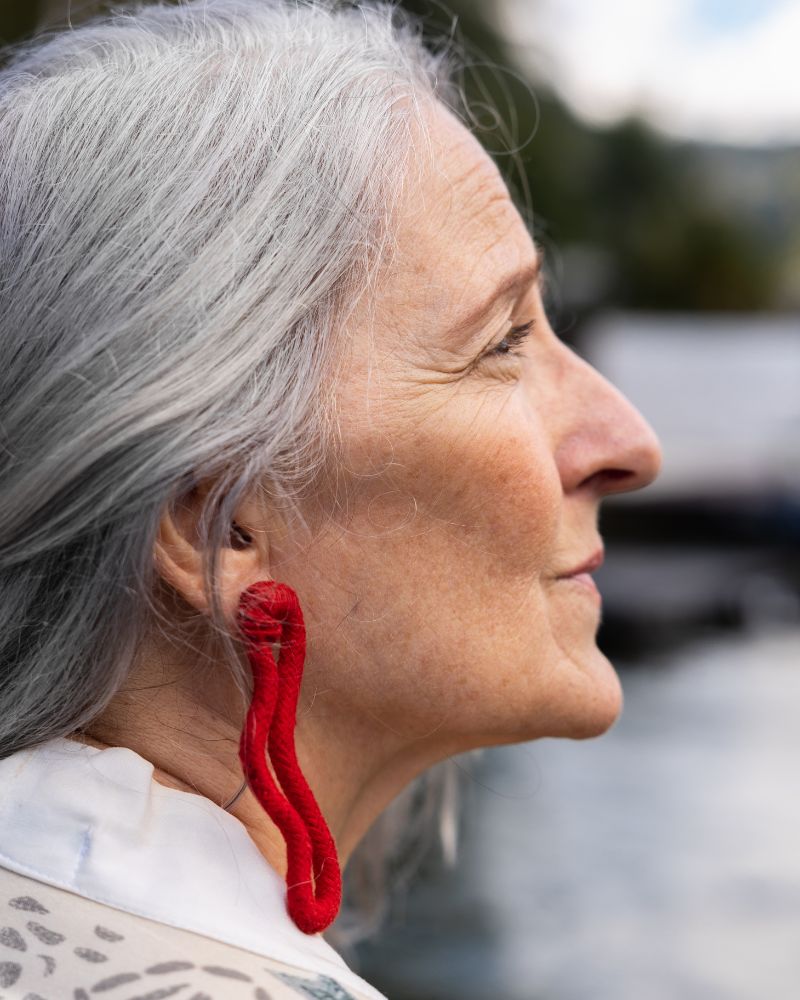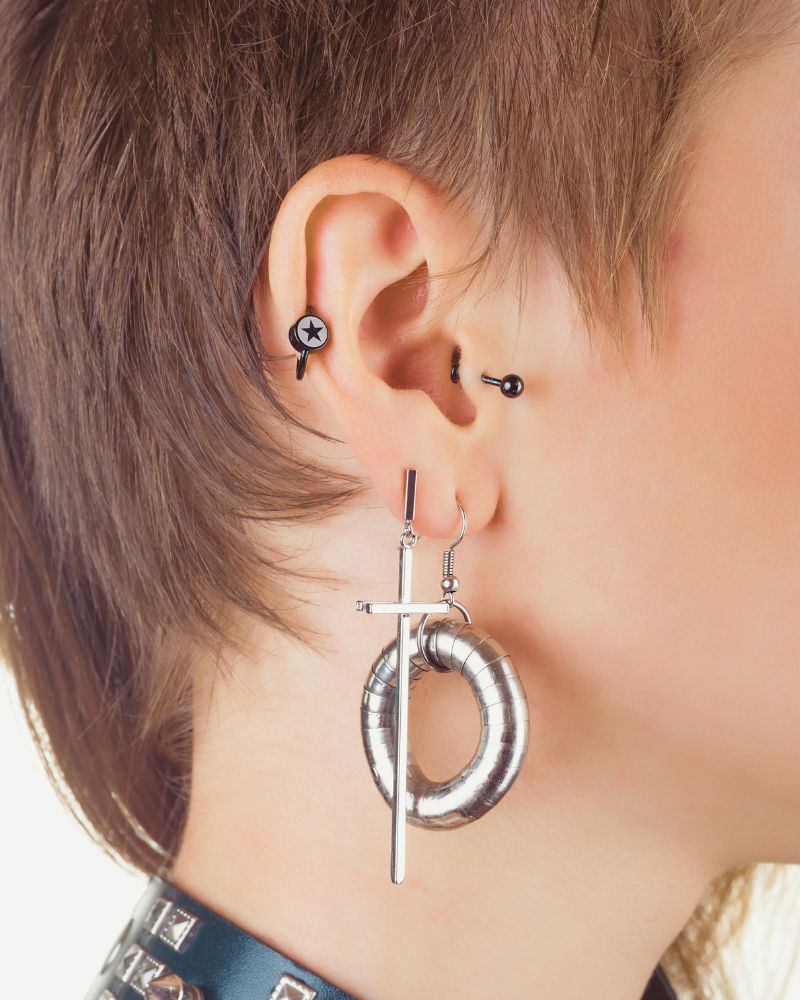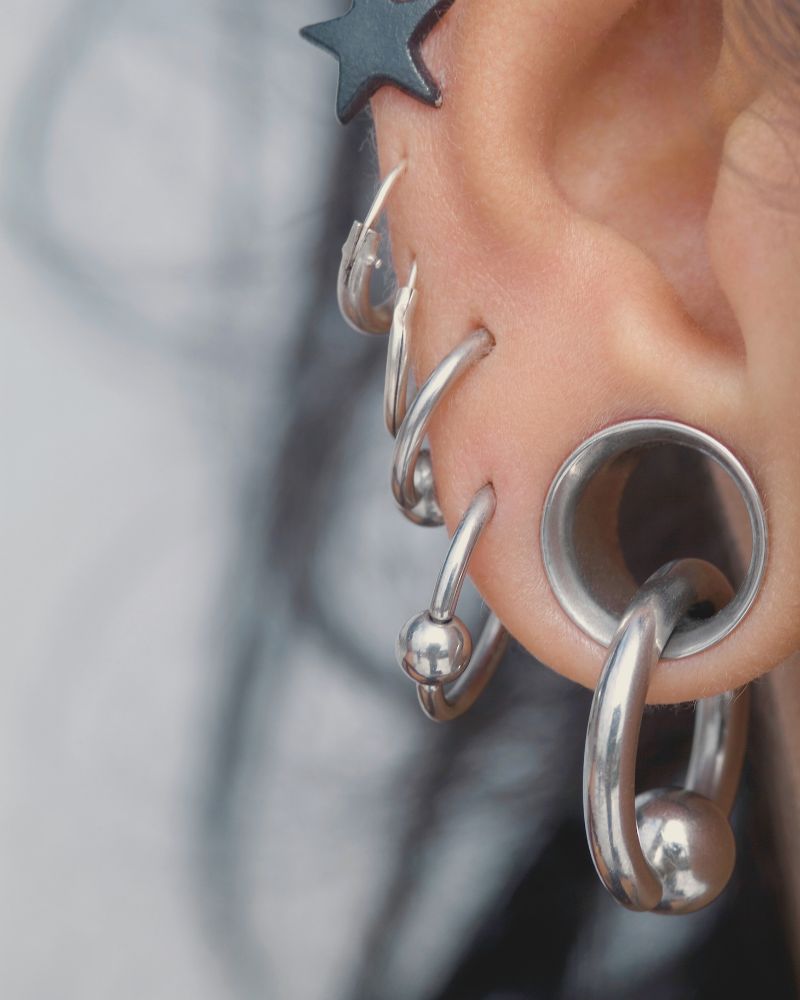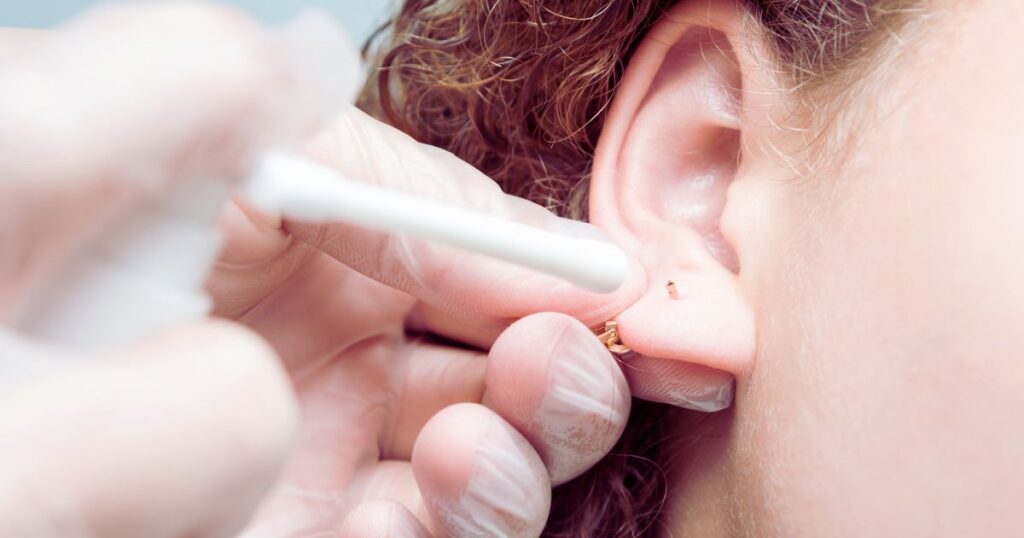As an Amazon affiliate, I may earn from qualifying purchases. Please read our Disclaimer and Privacy Policy.
Thinking about ear piercing over 50? You’re not alone. Women are embracing the fun, style, and personal expression of new ear piercings, no matter their age.
I honestly envy anyone with pierced ears.
Yes, I have pierced ears too, but it turns out I’m allergic to nickle. I’ve tried all the different alternatives for sensitive ears, but they must contain traces of the metal because I always end up with a bright red, itchy, inflammed rash.
I’d give anything to switch things up, add a bit of sparkle, or even just try something fresh and fun. Not wearing earrings (in my opinion) kind of a puts a damper on my look.
But hey, why are we talking about me? This post is all about you and your desire to join the trend of ear piercing over 50.
Ear piercing has come a long way from plain old stud earrings (one in each ear lobe). These days, it’s more about curating your own style. Not sure which one to try?
Don’t worry. In this post, I’ll take you through recent trends with an explanation on what they involve and cost. I’ll also explain the after-care procedures along with an idea of the pain level involved.

Why The Rise in Ear Piercing Over 50?
The best thing about ear piercing (besides the choices you have!) is that it doesn’t have an age restriction. In my opinion, it’s one of the best ways to embrace personal style.
Unlike a tattoo (which I also love), you can put earrings in or take them out. You can dress up your lobes with glittery magic, or tone it down for more serious business.
This year (2025) ear piercing trends focus on refined styles. This includes tiny studs, diamond studs, and subtle hoops.
Some of the reasons for the increase in ear piercings over 50 include the following:
Personal Expression
Older adults are embracing piercings to express their individuality and challenge age-related stereotypes, reclaiming their sense of self in later life.
Cultural Shifts
With piercings now mainstream and often inspired by older celebrities, the trend has become an age-inclusive form of self-expression.
A Celebration of Milestones
Piercings are often used to mark significant life events, such as retirement or personal achievements, especially as older adults feel freer from workplace restrictions.
Renewed Interest in Fashion
Modern jewelry designs appeal to older adults seeking elegant and stylish accessories, allowing them to participate in current fashion trends.
Symbolic or Emotional Reasons
For many, piercings symbolize transformation, healing, or shared experiences with loved ones, adding personal significance to the act.
Advances in Piercing Techniques
Improved techniques and safer materials make piercings more appealing and accessible, while specialized studios cater to older clients.
Financial Freedom
With more disposable income, older adults are investing in high-quality piercings and premium jewelry to enhance their experience.
Mental and Emotional Health
Piercings can boost confidence, challenge ageism, and serve as a reminder of personal strength and individuality, contributing to emotional well-being.

Different Ear Piercings Explained
As I mentioned earlier, ear piercings today are not limited to the lobes. These days, we have what’s called a “curated ear” where people are making ear piercing over 50 more than just functional.
Now, ear piercing over 50 has become a personalized form of wearable art! A Curated ear involves selecting placements and combinations that suit your ear shape, personal style, and preferences.
There are no “rules” in a curated ear. You can choose unique, mismatched, or layered pieces to suit your mood and style. The word of the day, in this case, is “intentional”.
The following definitions were as much of an educational eye-opener for me as they may be for you.
Helix Piercings
This trendy spot at the top of the ear is for a tiny stud or hoop.
- Pain Level: Moderate – cartilage piercings can be a bit painful.
- Healing Time: 6–12 months.
- Cost: $30–$80, depending on the studio and jewelry choice.
Examples of helix piercings: SkinKandy.com
Tragus Piercings
Located near your ear canal, tragus piercings are often paired with surgical steel or precious metals to avoid irritation.
- Pain Level: Moderate to High – the cartilage is thicker, so expect some discomfort.
- Healing Time: 6–12 months.
- Cost: $40–$90.
Examples of tragus piercings: Impuria.com
Forward Helix
Just above your ear lobe and closer to your face, this delicate spot is gaining popularity, especially for women who want a unique touch.
- Pain Level: Moderate – thinner cartilage than other areas, but still tender.
- Healing Time: 6–12 months.
- Cost: $40–$100.
Examples of helix piercings: Maria Tash
Multiple Lobe Piercings
For this trend, additional holes are added along the earlobe. This allows for creative earring combinations and a personalized look.
- Pain Level: Low – the lobe is soft tissue and relatively painless to pierce.
- Healing Time: 6–8 weeks.
- Cost: $20–$50 per piercing.
Examples of multiple lobe piercings and stacked lobe piercings: Bluebanana.com
Conch Piercing
The conch piercing is located in the inner cartilage of the ear. It can accomodate a stud or a hoop that encircles the ear’s outer edge.
- Pain Level: Moderate to High – the cartilage is thick and can be sensitive.
- Healing Time: 6–12 months.
- Cost: $40–$100.
Examples of conch piercings: atpresent.com
Daith Piercing
This piercing passes through the ear’s innermost cartilage fold.
- Pain Level: High – it’s a deep cartilage piercing, so it can be quite painful.
- Healing Time: 6–12 months.
- Cost: $50–$100.
Examples of daith piercings: freshtrends.com
Rook Piercing
This piercing is situated in the cartilage ridge, between the outer and inner ear.
- Pain Level: Moderate to High – the cartilage is thick, but the pain is short-lived.
- Healing Time: 6–12 months.
- Cost: $40–$90.
Examples of rook piercings: assolari.co

What to Look for in a Quality Piercing Shop
Not all piercing shops are created equal, so do your homework. Look for places with experienced staff, proper sterilization techniques, and good reviews.
Piercing Gun vs. Needle
Always opt for a needle over a piercing gun. It’s safer and reduces the risk of infection or allergic reaction.
Certification and Licensing
To start, check that the piercer has proper certifications and licensing.
A qualified professional should have training in body piercing and bloodborne pathogen safety.
It’s also essential to verify that the studio complies with local health regulations and holds a valid license to operate.
Cleanliness and Sterilization
A professional piercing studio should be visibly clean and organized, with separate areas for sterilization and piercing.
They should use an autoclave to sterilize their equipment and show you a sealed, sterile needle before starting. These are signs of a clean and safe environment.
Quality Jewelry
The jewelry offered is a key indicator of professionalism.
A skilled piercer will provide hypoallergenic options like titanium, surgical stainless steel, 14k or higher gold, or niobium.
The jewelry should be appropriately sized and designed to support healing and minimize irritation.
Tools and Technique
A qualified technician will use a hollow, single-use needle rather than a piercing gun.
Needles are more hygienic, precise, and less likely to damage tissue. This is a crucial distinction to look for when choosing a piercer.
Consultation and Communication
A professional piercer will take time to consult with you before the procedure.
They’ll discuss placement, explain potential risks, and provide detailed aftercare instructions.
If you have questions, they should answer them clearly and confidently, ensuring you feel comfortable moving forward.
Safety Practices
During the procedure, observe their safety practices. The piercer should wear disposable gloves and change them frequently.
All tools should come from sealed, sterilized packaging to ensure maximum hygiene and safety.
Reputation and Reviews
Research the studio’s reputation before making your choice.
Check online reviews on platforms like Google or Yelp to see what other customers have said. Recommendations from friends or family who’ve had good experiences can also be incredibly helpful.
Professional Affiliations
Membership in professional organizations like the Association of Professional Piercers (APP) is another strong indicator of a skilled and safety-conscious piercer.
These affiliations often require adherence to high standards.
Trust Your Instincts
Finally, listen to your gut. If the studio feels unclean or the technician seems unprofessional, it’s okay to walk away.
Finding a reputable piercer might take some time, but it’s worth the effort to ensure your experience is safe and enjoyable.

Piercing Aftercare Basics
The healing process is crucial to keeping your ears happy and healthy. Here’s what you need to know:
Clean with Saline Solution
Use a cotton swab to gently clean the area twice a day.
Avoid Hot Tubs
They can harbor bacteria and increase the risk of infection.
Choose the Right Materials
Precious metals like surgical steel or gold are less likely to cause irritation.
Listen to Your Body
If you notice signs of an allergic reaction or prolonged redness, consult a professional.
Signs of Metal Allergies
A metal allergy from an ear piercing, commonly caused by metals like nickel, can result in **allergic contact dermatitis**. Here are the typical signs to look for:
Immediate Signs (Within Hours or Days)
- Persistent itching around the piercing site.
- Redness or inflammation in the pierced area.
- Swelling at or near the piercing.
- A burning sensation, with the skin feeling hot or irritated.
- Development of a rash or small red bumps near the piercing.
Later or Prolonged Signs (After Days or Weeks)
- Dry, scaly skin that may peel.
- Formation of small fluid-filled blisters.
- Crusting or discharge of yellowish or clear fluid.
- Darkened skin around the piercing (hyperpigmentation).
- Delayed or unusually slow healing of the piercing.
Causes of the Allergic Reaction
Nickel is the biggest culprit when it comes to metal allergies in jewelry, but it’s not the only one—cobalt and chromium can also cause problems for some people.
Even jewelry labeled “hypoallergenic” or “stainless steel” isn’t always a safe bet, as it can sometimes have small amounts of these reactive metals hiding in the mix.
What To Do If You Have An Allergic Reaction to Metal
If you think you might be dealing with a metal allergy, the first step is to remove the earrings causing the issue.
Switch to jewelry made from hypoallergenic materials like titanium, surgical stainless steel, 14k or higher gold, or platinum.
These materials are less likely to trigger a reaction and can help your piercing heal more comfortably.
Next, take care of the irritated area by gently cleaning it with a saline solution or a mild antiseptic.
This will help reduce the risk of infection and keep the piercing clean as it heals.
If you’re dealing with persistent itching or inflammation, applying a small amount of hydrocortisone cream can provide relief—but be sure to check with a healthcare provider before using it.
5 Ear Piercing Over 50 Trends
The following are some of the most recent ear piercing over 50 trends.
Constellation Piercings
This trend involves multiple small piercings arranged to resemble star constellations, creating a unique and personalized pattern on the ear.
It’s typically done on the lobe, cartilage, or a combination of both areas.
Stacked Lobe Piercings
Stacked lobe piercings are a modern and stylish take on traditional earlobe piercings.
Instead of just a single row of piercings along the lobe, additional holes are placed vertically or slightly diagonally above the existing lobe piercings.
This creates a “stacked” effect, allowing for more creative and layered jewelry combinations.
Forward Helix Piercings
Located on the upper front part of the ear, this piercing stands out in a styled stack and can be adorned with delicate studs or hoops.
The forward helix is a small area, which makes the piercing understated but also eye-catching.
Some people opt for one, two, or even three forward helix piercings in a row.
Snakebite Piercings
Snakebite piercings refer to a piercing style where two piercings are placed symmetrically side-by-side, often close together, resembling the bite marks of a snake.
Though often linked to lip piercings, snakebite ear piercings refer to two closely positioned piercings on the lobe or cartilage, creating a balanced, edgy look.
Chain Industrial Piercings
An update to the traditional industrial piercing, this style uses a chain to connect two piercings, adding a delicate and modern twist.
By addressing the issue promptly and switching to hypoallergenic jewelry, most metal allergies can be managed effectively.
Why These Ear Piercings Over 50 Are Trending
For many women, getting their ears pierced after 50 isn’t just about adding new earrings to their collection—it’s a way to reconnect with themselves.
It might be a special bonding moment with a friend or family member, a fun way to celebrate a milestone, or simply a little treat for yourself as part of your self-care journey.
Whatever the reason, it’s a simple and exciting way to feel refreshed and fabulous.
Summary
Ear piercing over 50 is more than a trend—it’s a statement.
From cool ear piercings like helix piercings and tragus piercings to timeless choices like diamond studs in your first lobe, there’s something for everyone.
The piercing process is simple, especially if you find a reputable piercing shop or luxury piercing salon.
With proper aftercare and attention to your personal style, new piercings can be a safe and exciting way to enhance your look.

